Contents
Mass picking of mushrooms begins in September. In addition to such common and beloved mushrooms, mushrooms, boletus and boletus, in the first autumn month, quite rare species can also be found in the forests. These include collibia, lepista, lacquer, melanoleuca, tremellodon, and many others. Be careful: at this time in the Moscow region and other regions there are a lot of inedible varieties, so if in doubt, it’s better not to put unfamiliar mushrooms in your basket.
In September, many people with the whole family and individually during this period go mushroom hunting. Such trips to the forest warm the soul and cause a wonderful mood. Amazing colorful autumn landscapes of nature are very generously described and sung by our poets and writers.
Edible mushrooms that grow in September
Spruce mokruha (Gomphidius glutinosus).
Mokruhi are among the first to grow in autumn. They may appear earlier, but it is in September that their peak of growth is observed. To collect them, you need a basket or a separate compartment in the basket, as they stain all other mushrooms. Interestingly, these mushrooms grow in the forest in September in almost the same places as porcini mushrooms, but later for half a month or a month.
Habitats: on the soil and forest floor in coniferous, especially spruce forests, grow in groups or singly.
Season: June – October.

The cap has a diameter of 4-10 cm, sometimes up to 14 cm, fleshy, at first convex-conical with folded edges, later prostrate. A distinctive feature of the species is a slimy gray-lilac or gray-brown cap, covered with a mucous membrane of thin filamentous fibers, as well as the cone-shaped nature of the plates descending along the stem and the presence of yellow spots at the base of the stem. The skin is easily removed completely.
The leg is 4-10 cm high, 8 to 20 mm thick, sticky, whitish, with characteristic yellowish spots, especially pronounced near the base. This film breaks as the fungus grows and forms a brownish mucous ring on the stem.

Pulp: whitish, soft and brittle, odorless and slightly sour in taste.
The plates are adherent, sparse, highly branched, descending along the stem along a cone-shaped surface. The color of the plates in young mushrooms is whitish, later gray and then blackish.
Variability. The color of the cap can vary from gray-lilac, brown-violet to brownish. Mature mushrooms have black spots on the cap.

Similar types. Spruce mokruha is similar in description to pink mokruha (Gomphidius roseus), which is distinguished by a coral-reddish cap color.
Edibility: good edible mushrooms, but it is necessary to remove the sticky skin from them, they can be boiled, fried, canned.
Edible, 3th category.
Collybia is forest-loving, light form (Collybia dryophilla, f. albidum).
Habitats: mixed and coniferous forests, on the forest floor, in moss, on rotting wood, stumps and roots, grow in groups, often in witch circles.
Season: these mushrooms grow in the Moscow region from May to September.

The cap has a diameter of 2-6 cm, sometimes up to 7 cm, at first convex with a lowered edge, later prostrate, flat, often with a wavy edge. A distinctive feature of the species is the light color of the cap: whitish, or white-cream, or white-pink. The central area may be slightly brighter.

Leg 3-7 cm tall, 3-6 mm thick, cylindrical, widened near the base, hollow inside, pinkish or yellow-cream above, darker at the base – reddish or brownish, pubescent.

The flesh is thin, whitish, with a slight mushroom smell and a pleasant taste.
The plates are cream or yellowish, adherent. Between the adherent plates are short free plates.
Variability: the color of the cap is variable depending on the maturity of the mushroom, the month and the humidity of the season – from white-cream to pinkish-cream.

Similar types. Collibia forest-loving is similar in shape and main color to inedible Collybia distorta (Collybia distorta), which can be distinguished by a uniformly colored yellow-orange cap.
Cooking methods: warka, jarka, konservirovanie.
Edible, 4th category.
White whip (Pluteus pellitus).
Habitats: on rotting hardwood, on rotting sawdust, grow in groups or singly.
Season: these mushrooms grow from June to September.

The cap has a diameter of 3-7 cm, first bell-shaped, then convex and then prostrate, almost flat. A distinctive feature of the species is a whitish cap with a small tubercle with a brownish tint, as well as a whitish cylindrical leg. The cap is radially fibrous, the edges are slightly lighter.

The stem is 4-8 cm high, 4 to 10 mm thick, cylindrical, longitudinally fibrous, hard, solid, first white, later grayish, or ash-cream, sometimes yellowish, slightly thickened at the base.

Pulp: white, soft, thin, without much odor.
The plates are frequent, wide, notched-attached or free, white, later pinkish or cream.
Variability. The color of the cap varies from whitish to bluish-white, and the tubercle varies from yellowish to brownish.

Similar types. The white whip is similar in description to the golden yellow whip (Pluteus luteovirens), which is distinguished by a change in the color of the cap in adults to golden yellow and has a darker brown center.
Edibility: only caps are edible, they are boiled, fried, pickled, dried.
These September mushrooms are edible, belong to the 4th category.
Tremellodon.
The appearance of tremellodons, tremblings, meruliuses indicates the imminent approach of a real cool autumn season. These mushrooms are translucent, in composition they resemble a semi-solid, translucent jelly. They grow on stumps or branches.
Gelatinous tremellodon (Exidia Tremellodon gelatinosum).
Habitats: on rotting wood and stumps of conifers covered with moss, less often on hardwoods. A rare species, listed in some regional Red Books.
Season: July – September.

The fruiting body has an eccentric lateral leg. The size of the cap is from 2 to 7 cm. A distinctive feature of the species is a gelatinous wavy petal type fruit body of lilac or yellowish-violet color with white spines on the back of the cap. The edges of the cap are pubescent, spruce.

The leg is lateral, oval in cross section, 0,5-3 cm high, 2-5 mm thick, whitish, gelatinous.
Pulp: gelatinous, yellowish-gray, with a peppery taste.
Variability. The color of the fruiting body can vary mainly from the humidity and rainy season from lilac to lilac brown.
Similar types. Tremellodon gelatinosa is so characteristic due to its unusual wavy shape and translucent lilac consistency of the fruiting body that it is easily identified. Cooking Methods: Spicy seasonings are made from these mushrooms. In China and Korea, they are bred and eaten raw or made into spicy sauces.
Edible, 4th category.
Dirty lepista, or titmouse (Lepista sordida).
Habitats: deciduous and coniferous forests, in parks, vegetable gardens, orchards, usually grow singly. A rare species, listed in some regions of Our Country in the Red Book, status – 3R.
Season: June – September.

The cap is thin, has a diameter of 3-5 cm, sometimes up to 7 cm, at first convex-rounded, later flat-prostrate, broadly bell-shaped. A distinctive feature of the species is the gray-pink-violet color of the cap, the presence of a flat tubercle in the center and a brownish tint in its central region, as well as in young specimens the edges are twisted down, and later just slightly down.

Leg 3-7 cm high, 4-9 mm thick, cylindrical, solid, dirty brown-violet.

The pulp of the September mushroom is soft, gray-lilac or grayish-violet, with a mild taste and almost no smell.
The plates are frequent, at first accreted, later notched-adhered. Between the main attached plates are short free plates.
Variability: the color of the cap varies from lilac to lilac and violet. In most specimens, the caps are uniformly colored with a slight increase in purple hue near the tubercle. However, there are specimens in which the central zone is lighter than the rest, purple-lilac or lilac.

Similar types. Dirty lepista, or titmouse, is similar to purple rows (Lepista nuda), which are also edible, but differ in a thick, rather than thin, fleshy hat, large size and a more pungent odor in the pulp.
Cooking methods: boiled, fried.
Edible, 4th category.
Melanoleuca.
Melanoleuca is similar to russula, but differs in flesh color and smell.
Short-legged melanoleuca (Melanoleuca brevipes).
Habitats: deciduous and mixed forests, as well as in clearings, grow in groups.
Season: September – November.

The cap has a diameter of 4-12 cm, at first convex, later convex-prostrate with a blunt tubercle, later almost flat. A distinctive feature of the species is a dirty yellow or walnut hat with a darker middle.

The stalk is short, 3-6 cm high, 7-20 mm thick, cylindrical, slightly widened near the base, first gray, later brown.
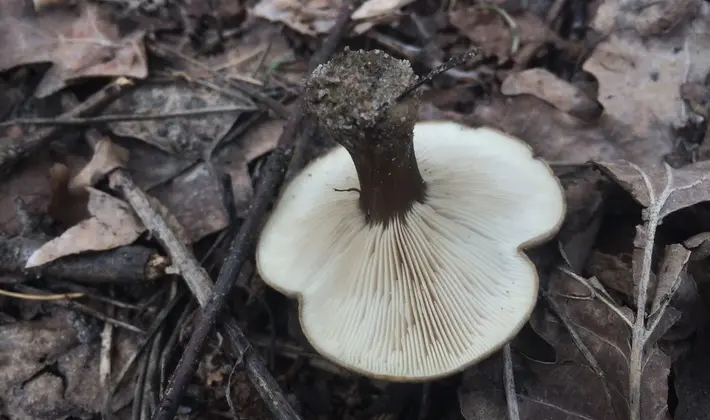
The flesh is brownish, later brownish, with a powdery smell.
The plates are frequent, adherent, at first creamy, later yellowish.
Variability: the color of the cap varies from gray-yellowish to gray-brown, often with an olive tint.

Similar types. Melanoleuca short-legged according to the description is similar to inedible melanoleuca melaleuca (Melanoleuca melaleuca), which has a long smooth leg.
Cooking methods: boiled, fried.
Edible, 4th category.
Large lacquer (Laccaria proxima).
Habitats: mixed and deciduous forests, growing in groups or singly.
Season: September – November.

The cap has a diameter of 2-8 cm, at first semi-spherical, later convex and convex-prostrate with a slightly depressed center. A distinctive feature of the species is the reddish-brown or lilac-brown color of the cap with a slight depression in the center.

Stem 2-8 cm tall, 3-9 mm thick, cylindrical, cream at first, later cream pink and brown. The upper part of the leg is colored more intensely. The surface of the stem is fibrous and pubescent near the base.
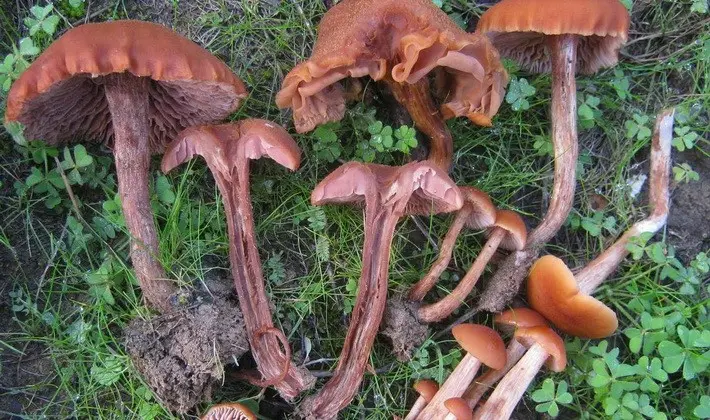
The flesh is light brown, without a definite taste and smell.
Records of medium frequency, adherent, at first cream-colored, cream-purple.
Variability: the color of the cap of these September mushrooms varies from light orange to reddish brown.
Similar types. The lacquer, large in appearance and color, can be confused with the sharpest inedible milkweed (Lactarius acerrimus). Milky can be distinguished by the characteristic fruity smell and the presence of milky juice.
Cooking methods: warka, jarka, konservirovanie.
Edible, 4th category.
Below you will find out what other mushrooms are harvested in September in the Moscow region and other regions.
Other edible mushrooms growing in September
The following mushrooms are also harvested in September:
- autumn mushrooms
- Ryadovki
- Blackberries
- Raincoats
- cobwebs
- Shiitake
- Dairymen
- Chanterelles
- Russule
- White mushrooms
- Orange-cap boletus
- Boletus.
Next, you will find out which inedible mushrooms grow in the forest in September.
Inedible September mushrooms
I’m leaving.
Otideas are more resistant to frost than other mushrooms due to their structure. These mushrooms consist of fruiting bodies in the form of thick yellowish films.
Donkey otidea (Otidea onotica).
Habitats: on the forest floor in mixed forests, growing in groups.
Season: September – November.

The fruit body has a size of 2 to 8 cm, a height of 3 to 10 cm. A distinctive feature of the species is a yellow-straw, yellow-orange fruit body with elongated parts that look like donkey ears. The outer surface has a granular or powdery coating. The inside is yellow-brown. Rusty spots appear on the outer surface over time.

The base of the fruiting body: leg-shaped.

Pulp: brittle, thin, light yellow. Variability. The color of the fruit body can vary from light brown to yellow-orange.
Similar types. The donkey otidea is similar in color to the graceful otidea (Otidea concinna), which is distinguished by its cup-shaped shape.
These September mushrooms are inedible.
Mycenae.
Mycenae in September is especially plentiful. They capture all large surfaces of stumps and rotting trees. At the same time, they are distinguished by a variety of colors – from bright burgundy to pale cream.
Mycena Abrams (Mycena Abramsii).
Habitats: on stumps and deadwood, mostly hardwoods, grow in groups.
Season: July – September.

The cap has a diameter of 1-4 cm, first bell-shaped, then convex. A distinctive feature of the species is a yellowish-pink or pinkish-cream color, strongly tuberculate in the center, with a furrowed and lighter white-cream edge.

Leg 4-7 cm tall, 2-5 mm thick, cylindrical, smooth, cream or light brown at first, later grayish-brown, darker at the base. The stalk often has white hairs at the base.
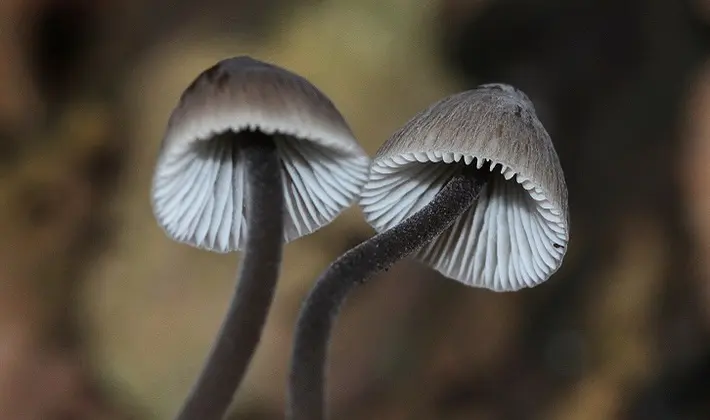
The pulp is thin, light cream.
Records of medium frequency, notched-grown, wide, whitish with a flesh tint, sometimes creamy pinkish.
Variability: the color of the cap varies from yellowish-pink to yellowish-reddish and ocher-pinkish. The striated edge is lighter in color and curves over time.
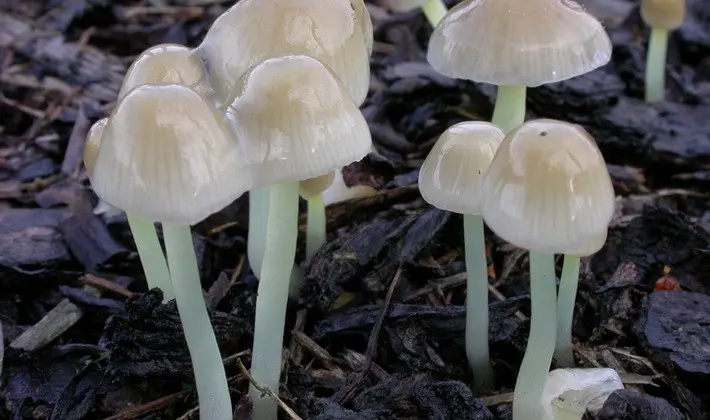
Similar types. Mycena Abrams is also similar to the inedible mycena sticky (Mycena epipterygia), which is distinguished by a long tricolor leg: whitish above, yellowish in the middle, and brown at the base.
Edibility: the unpleasant odor is hardly softened when decoction in 2-3 waters, for this reason they are not eaten.
Inedible.
Mycena red-marginal (Mycena rubromarginata).
Habitats: pastures, meadows, moss peat, on rotten wood.
Season: August – November.

The hat has a diameter of 1-3 cm, at first sharply bell-shaped, later – cap-shaped. A distinctive feature of the species is the bell-shaped cap with a tubercle, which often has a small light pinkish ring, around which the central pinkish-reddish cap zone is located; the edges are reddish or creamy pink, but always lighter than in the middle. The surface of the cap has radial strokes that coincide with the location of the plates below the cap.

The leg is long and thin, 2-8 cm high, 1-3 mm thick, hollow, brittle, cylindrical. The color of the stem is the same as the cap, but it is lighter. The stem at the base has white fibrous flakes.

The pulp is thin, whitish, with the smell of radish, the flesh of the leg is pinkish, it smells like radish.
The plates are adherent, wide, sparse, whitish-gray with a flesh tint, sometimes pinkish.
Variability: the color of the middle of the cap varies from pinkish to purple. The striated margin is lighter in color and curves upward over time.

Similar types. Red-marginal mycenae are confused with blood-legged mycenae (Mycena epipterygia) because of the similar red color of the cap. However, bloodspindle mycenae can be quickly distinguished by their pointed cap shape and lack of odor, while red-margined mycenae smell like radishes.
These September mushrooms are inedible due to their unpleasant smell and taste.
Mycena sticky (Mycena epipterygia)
Habitats: mixed and deciduous forests, on rotting wood, usually grow in groups.
Season: July – November.
The cap has a diameter of 1-3 cm, first pointed, then bell-shaped. A characteristic property of the species is the ovoid-bell-shaped cap of gray or gray-brown color with a clearly visible radial shading, reflecting the position of the plates. The color of the cap at the crown is slightly more intense than at the edges.
The leg is thin, 2-6 cm high, 1-3 mm thick, dense, sticky. The second distinguishing property of the species is the color of the stem, it changes from top to bottom, at the cap it is creamy gray, yellowish in the middle, below yellowish brownish, brownish or brownish at the base, sometimes with a hint of rust.
The pulp is thin, watery.
The plates are rare, widely adherent, whitish in color.
Variability: the color of the cap varies from gray to buff and grey-brown.

Similar types. Mycenae are sticky in color, caps and legs are similar to thin-capped mycenae (Mycena leptocephala), which are easily distinguished by the smell of chlorinated water.
They are inedible because they are tasteless.
Mycena pure, white form (Mycena pura, f. alba).
Habitats: deciduous forests, among moss and on the forest floor, grow in groups.
Season: June – September.
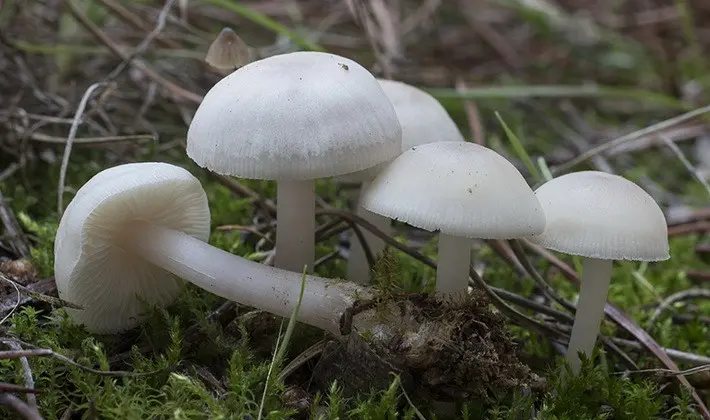
The cap has a diameter of 2-6 cm, at first cone-shaped or bell-shaped, later flat. A distinctive feature of the species is an almost flat shape of gray-walnut or gray-cream color, with a tubercle of light brown color and radial scaly shading on the surface.

Leg 4-8 cm high, 3-6 mm thick, cylindrical, dense, the same color as the cap, covered with many longitudinal fibers.
The flesh of the cap is white, with a strong smell of radish.
Records of medium frequency, wide, adherent, between which there are shorter free records.
Variability: the color of the cap varies from gray-cream to whitish.

Similar types. This mycena is similar to milk mycena (Mycena galopus), which is distinguished by the brown color of the legs.
These September mushrooms are inedible.
Collybia oil, asema form (Collybia butyracea, f. asema).
Habitats: mixed and coniferous forests, growing in groups.
Season: May – September.

The cap has a diameter of 2-5 cm, at first convex with a lowered edge, later convex-prostrate. A distinctive feature of the species is a hat with three zones: the central, darkest one is brownish, the second concentric one is cream or creamy pink, the third concentric zone at the edges is brownish.

Leg 3-7 cm high, 3-8 mm thick, cylindrical, white at first, later light cream and gray-cream. Near the base of the stem, over time, separate zones of a reddish-brown color appear.

The pulp is dense, fibrous, whitish, without any special smell, the spore powder is light cream.
Records of medium frequency, first white, later cream, notched-attached.
Variability: the color of the central zone of the cap varies from brownish to brown, and the concentric zones – from cream to yellow-brown.

Similar types. This species is similar to Collybia dryophila, which also has concentric cap color zones, but they have a reddish-brown central zone and a yellowish-cream following zone.
Inedible.
Youthful whip (Pluteus ephebeus).
Habitats: on rotting wood and stumps, on sawdust of coniferous and deciduous trees, grow in groups or singly.
Season: June – September.

The cap has a diameter of 3-7 cm, at first bell-shaped, then convex and prostrate. A distinctive feature of the species is a finely scaly gray-black hat and an even leg with small blackish scales.

Leg 3-10 cm high, 4 to 10 mm thick, cylindrical, slightly expanding at the base. The leg is grayish in color, and the longitudinal fibers on it are either black or dark brownish. The leg becomes hollow over time.

Pulp: soft with a pleasant taste and smell.
The plates are frequent, whitish at first, then cream and pinkish with a dark brown edge.
Variability. The color of the cap varies from gray-black to mouse.

Similar types. The youthful scourge is similar to the small scourge (Pluteus nanus), which is distinguished by a smooth gray-brown hat with a flat tubercle.
These September mushrooms are inedible.
Hymnopil.
If winter mushrooms do not have poisonous twins in winter, then in autumn they are. These include hymnopiles, or moths.
Gymnopil penetrating (Gymnopilus penetrans).
Habitats: on stumps and near dead wood in deciduous forests, growing in groups.
Season: september – november
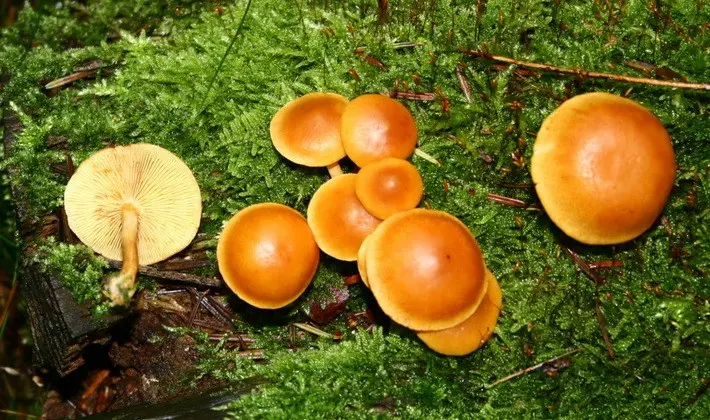
The cap has a diameter of 2-7 cm, at first strongly convex, later prostrate. A distinctive feature of the species is the yellowish-orange color of the cap with a lighter shade on the edges, with a central or eccentric stem, as well as with plastics that darken not over the entire surface, but closer to the stem.

The leg is either central or eccentric, slightly lighter than the cap or of the same color, uneven, with bends, 3-8 cm high, 4-9 mm thick.

The flesh is whitish at first, later yellowish.
The plates are adherent, descending along the stem, in young specimens they are light yellow, and eventually purple-brown, and the color does not immediately cover the entire reverse side of the cap, but gradually, occupying the entire area.
Similar types. The hymnopile, penetrating by the color of the cap and the absence of a ring, is very similar to the winter honey agaric, and there are many cases when they are confused. It should be noted that these mushrooms are not poisonous, they are inedible, as they are tasteless, as if chewing grass. It is not difficult to distinguish them by the plates – in honey mushrooms they are free and bend inward, while in the hymnopile they are grown and slightly descending. In addition, the hymnopile plates are much more frequent.
Edibility: inedible.
Gymnopilus hybrid (Gymnopilus Hybridus).
Habitats: on stumps and near dead wood in deciduous and coniferous forests, next to firs, grow in groups.
Season: September – November.

The cap has a diameter of 2-9 cm, at first strongly convex, later prostrate with edges slightly bent down. A distinctive feature of the species is the yellowish-orange color of the cap with a lighter shade on the edges, with a central or eccentric stalk and with a tubercle in young specimens.

The leg is either central or eccentric, slightly lighter than the cap or of the same color, uneven, with bends, 3-8 cm high, 4-9 mm thick. There is a trace of a ring on the leg. The stem is darker than the cap.

The flesh is whitish at first, later yellowish.
The plates are frequent, adherent, descending along the stem, light yellow in young specimens, and with time rusty-brown.
Similar types. The hybrid hymnopile is immediately similar in three ways to winter mushrooms: in the color of the cap, the absence of rings and free plates. It should be noted that these mushrooms are not poisonous, they are inedible, as they are tasteless, as if chewing grass. It is not difficult to distinguish them by the plates: the hymnopile has very frequent plates.
Edibility: inedible.
Gymnopilus (moth) bright (Gymnopilus junonius).
Habitats: on stumps and near dead wood in deciduous and coniferous forests, growing in groups.
Season: September – November.
The cap has a diameter of 2-5 cm, at first convex, almost hemispherical, later prostrate with slightly curved edges. A distinctive feature of the species is a dry, yellowish-orange hat covered with fibers. The edges of the cap are lighter, with the remains of a bedspread.
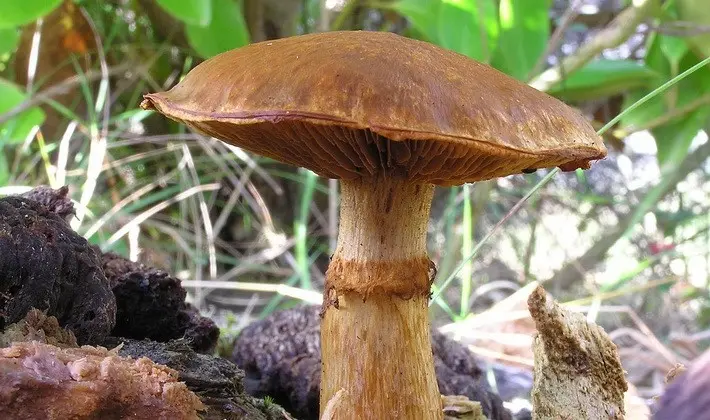
The stem has the same color as the cap, has a thickening at the base. Leg height – 3-7 cm, thickness 4-7 mm. The second distinguishing feature is the presence of a dark ring at the top of the stem. The surface of the leg is covered with fibers.

The flesh is whitish at first, later yellowish.
The plates are frequent, adherent, descending along the stem, light yellow in young specimens, and with time rusty-brown.
Similar types. Gymnopile, or bright moth, because of the color and the presence of the ring, it looks like a summer honey agaric, and because of the color and shape of the hat in adult specimens, it looks like a winter honey agaric. This mushroom should be clearly distinguished from honey mushrooms, as it is deadly poisonous. It differs from summer honey agaric in having a single-colored hat without a lighter zone in the middle of the hat, and from winter honey agaric in the presence of a ring and much more frequent plates.
Edibility: deadly poisonous!
Calocera.
Now it’s time for the horns. They appear, it would seem, on the ground, but in fact most often on the roots of plants and on old, half-rotten trunks.
Calocera viscosa (Calocera viscosa).
Habitats: forest floor or dead wood of deciduous and mixed forests, growing in groups.
Season: September – November.
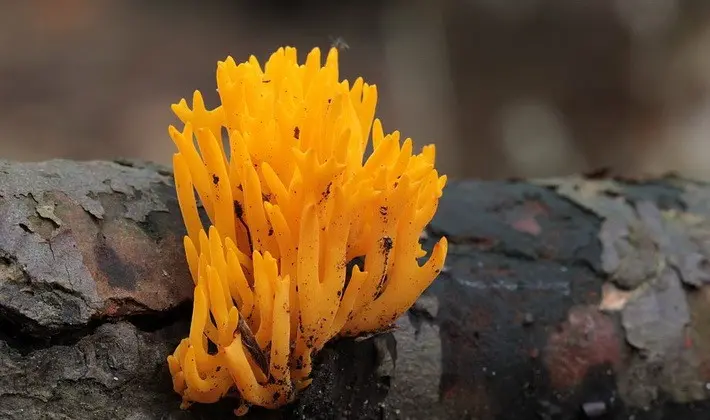
The fruit body has a height of 1-5 cm, it consists of separate fruiting bodies in the form of branched horns. A distinctive feature of the species is the yellowish-lemon color of branched horns; several of them can grow from one base.

Leg. There is no separate, distinctly expressed leg, but there is a small base from which branched horns extend.
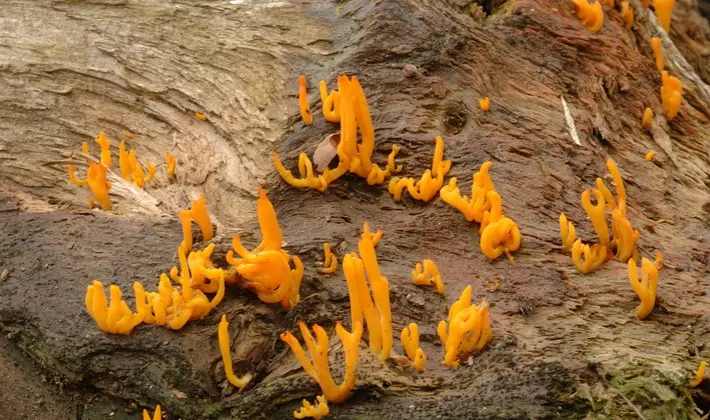
Pulp: elastic, yellow, dense, the same color as the fruiting body.
Records. There are no plates as such.
Variability. The color of the fruiting body can vary from yellowish to yellowish lemon to yellowish greenish.
Similar types. Calocera sticky in description is similar to horn-shaped calocera (Calocera cornea), which is distinguished by the absence of branching of fruiting bodies.
Inedible.
Merulius tremellosus (Merulius tremellosus).
Habitats: on fallen hardwood trees, growing in rows.
Season: September – November.

The fruit body has a width of 2-5 cm, a length of 3-10 cm. A distinctive feature of the species is a prostrate semicircular, fan-shaped translucent fruit body of pinkish color with lighter white edges. The surface of the fruiting body is hairy-prickly, the edges are wavy.

Hymenophore: reticulate, cellular-sinuous, creamy pinkish, brighter at the base.
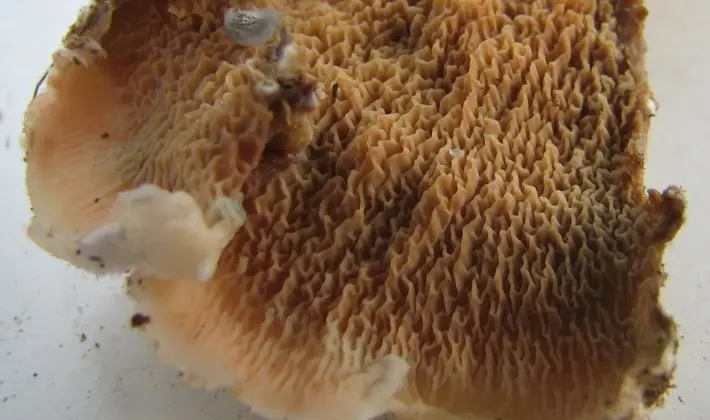
The pulp is thin, elastic, dense, without any special smell.
Variability. The color of the fruiting body varies from pink to cream.
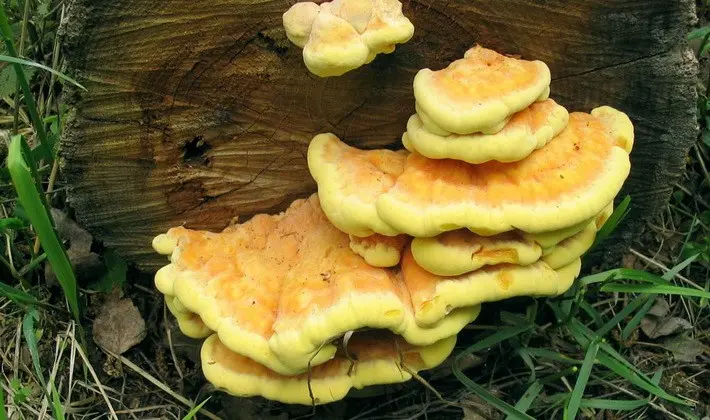
Similar types. Merulius trembling is similar to the sulfur yellow tinder fungus (Laetiporus sulphureus), which differs not in sharp, but in rounded edges and an opaque consistency of the fruiting body.
Inedible.
Brown-yellow talker (Clitocybe gliva).
Season: July to September
Habitats: mixed and coniferous forests, growing singly or in groups.

The cap is 3-7 cm in diameter, sometimes up to 10 cm, at first convex with a small flat tubercle and an edge bent downwards, later flat with a small depression and a thin wavy edge, matte. A distinctive feature of the species is a brownish-orange or reddish, yellow-orange, brownish-yellowish cap with rusty or brown spots.

Leg 3-6 cm high, 5-12 mm thick, cylindrical, even or slightly curved, slightly narrowed towards the base, fibrous, with white pubescence near the base, the same color with a cap or lighter, often yellow-ocher.

The flesh is firm, creamy or yellowish, with a pungent odor and slightly bitter.
The plates are frequent, narrow, descending along the stem, attached, sometimes forked, at first light or yellowish, later brownish with rusty spots.
Variability: the color of the cap varies from light and yellowish-orange to brown-orange.

Similar types. The brown-yellow talker in shape, size and main color of the cap resembles an edible bent talker (Clitocybe geotrapa), which is distinguished by the absence of rusty spots and has a strong fruity smell of pulp.
Edibility: mushrooms are poisonous due to the content of muscarine.
Poisonous.
Hornbill straight (Ramaria stricta).
Habitats: forest floor or dead wood of deciduous and mixed forests, growing in groups or rows.
Season: July – September.
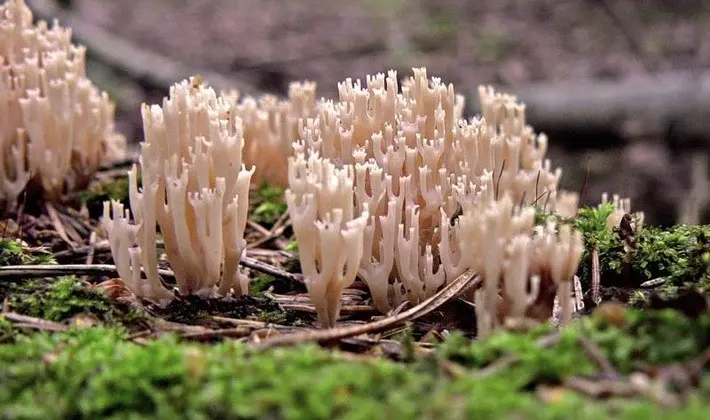
The fruit body has a height of 4-10 cm, sometimes it consists of many individual branched branches. A distinctive feature of the species is a coral-like form of white-cream or whitish-pinkish color from many branched bodies with pointed one- or two-parted tops. Separate “branches” of the fungus are pressed against each other, branching begins at a height of from half to two thirds of the total height of the fruiting body.

Leg. There is no separate, distinctly expressed stem, but there is a small base from which branched fruiting bodies extend, the width of the entire bush is from 3 to 8 cm in width.
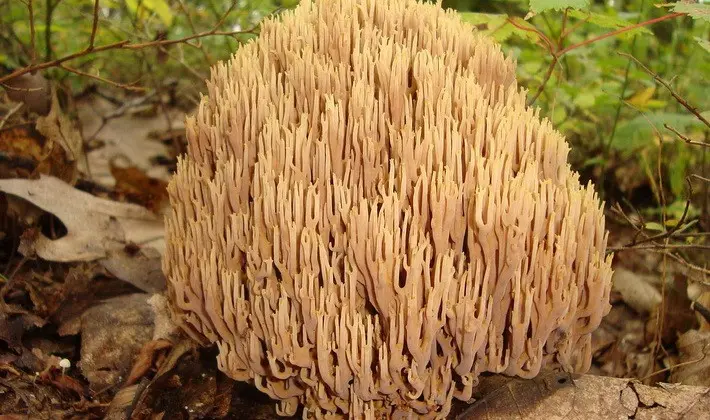
Pulp: whitish or creamy, later becoming reddish
Records. There are no plates as such.
Variability. The color of the fruit body can vary from white-cream to yellowish and ocher brown.

Similar types. The straight horn looks like comb hornbill (Clavulina cristata), which is distinguished by “twigs” with scallops and fringe at the tops.
Inedible.









